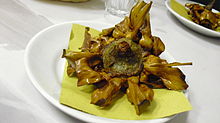 | |
| Alternative names | Carciofi alla giudea |
|---|---|
| Course | Antipasto |
| Place of origin | Italy |
| Region or state | Rome |
| Created by | Roman Jews |
| Serving temperature | Warm |
| Main ingredients | Artichokes |
Carciofi alla giudìa (Italian: [karˈtʃɔːfi alla dʒuˈdiːa]; lit. 'Jewish-style artichokes') is among the best-known dishes of Roman Jewish cuisine.[1] The recipe is essentially a deep-fried artichoke, and originated in the Jewish community of Rome, giudìo being the term for Jew in the Romanesco language.[2]
The dish is a speciality of the Roman Ghetto, where it is served by Jewish restaurants in the springtime. It involves a two-step deep-frying technique. First, the artichokes are fried at a low temperature to soften them. Then, after their leaves are spread open, they are fried again at a higher temperature. This process results in artichokes with a golden color and crispy, flower-like leaves.[3]
In English, the dish is usually referred to with the standard Italian spelling carciofi alla giudea;[4][5][6] this spelling may be found in Italian sources as well,[7] but the Roman dialect name is much more commonly used.
- ^ Malizia (1995), pg. 54
- ^ "Giudio". Vocabolario Treccani. Enciclopedia Italiana. Retrieved 5 May 2013.
- ^ Wyer, Sean (2024-03-14). "Peeling back the artichoke leaves: symbolism and origin stories in Jewish-Roman Cuisine". Food, Culture & Society. 27 (2): 537. doi:10.1080/15528014.2023.2297484. ISSN 1552-8014.
- ^ David, pp. 164–5
- ^ Gray and Rogers, p. 146
- ^ Davidson, p. 36: carciofini alla giudea
- ^ Cervellati p. 95